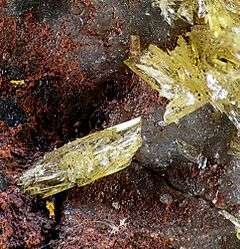Carlfriesite
| Carlfriesite | |
|---|---|
|
Carlfriesite from Moctezuma Mine, Moctezuma, Municipio de Moctezuma, Sonora, Mexico. Picture width: 2 mm. | |
| General | |
| Category | Tellurate minerals |
| Formula (repeating unit) | CaTe4+2Te6+O8 |
| Strunz classification | 4.JK.25 |
| Dana classification | 34.5.3.1 |
| Crystal system | Monoclinic |
| Crystal class |
Prismatic (2/m) H-M symbol: (2/m) |
| Space group |
Monoclinic Space group: C2/c |
| Unit cell |
a = 12.576, b = 5.662 c = 9.994 [Å], Z = 4 |
| Identification | |
| Color | Bright yellow - buttery yellow |
| Crystal habit | Axe-head shaped crystals, botryoidal crusts or radial crystals. |
| Cleavage | Distinct |
| Tenacity | Brittle |
| Mohs scale hardness | 3.5 |
| Luster | Vitreous |
| Streak | Pale yellow |
| Diaphaneity | Transparent |
| Specific gravity |
6.3 (measured) 5.7 (calculated) |
| Optical properties | Biaxial (-) |
| Birefringence | δ = 0.208 |
| Pleochroism | Weak, shades of yellow |
| 2V angle | 80 |
| Ultraviolet fluorescence | None |
| Solubility | Insoluble |
| References | [1] |
Carlfriesite is a rare tellurium mineral with the formula CaTe4+2Te6+O8, or more simplified: CaTe3O8. It has a Moh's hardness of 3.5 and it occurs in various shades of yellow, ranging from bright yellow to a light buttery color. It was named after Carl Fries Jr. (1910–1965) from the U.S. Geological Survey and the Geological Institute of the National University, Mexico City, Mexico.[2][3][4] It was previously thought to have the formula H4Ca(TeO3)3, but this was proven to be incorrect.[5] It has no uses beyond being a collector's item.
Occurrence
Carlfriesite is often found in cavities in hydrothermal gold-tellurium deposits. It is found associated with cerussite, chlorargyrite, argentian gold, cesbronite, calcite, dickite, baryte, bornite, galena, hessite and tlapallite.[4] It was first identified in the Bambollita (La Oriental), Moctezuma, Municipio de Moctezuma, Sonora, Mexico. It is also found in another nearby mine, namely the Moctezuma mine.
Synthesis
Carlfriesite was found to be synthesizable by heating a mixture of CaO, Te(OH)6 and TeO2 to 150-240°C with water at the vapor pressure of the system. The resulting material was very fine-grained and colorless, consisting of aggregates of tiny carlfriesite plates. The material mostly consisted of carlfriesite, but also contained 10-15% paratellurite, as determined by X-ray diffraction.[5]
See also
References
- ↑ Mineralienatlas
- ↑ Barthelmy, Dave. "Carlfriesite Mineral Data". www.webmineral.com. Retrieved 2016-09-19.
- ↑ "Carlfriesite: Carlfriesite mineral information and data.". www.mindat.org. Retrieved 2016-09-19.
- 1 2 "Handbook of mineralogy" (PDF). Retrieved 2016-09-19.
- 1 2 Herta Effenberger, Josef Zemann, Helmut Mayer (1978). "Carlfriesite: crystal structure, revision of chemical formula, and synthesis" (PDF). American Mineralogist. 63. Retrieved 2016-09-19.
